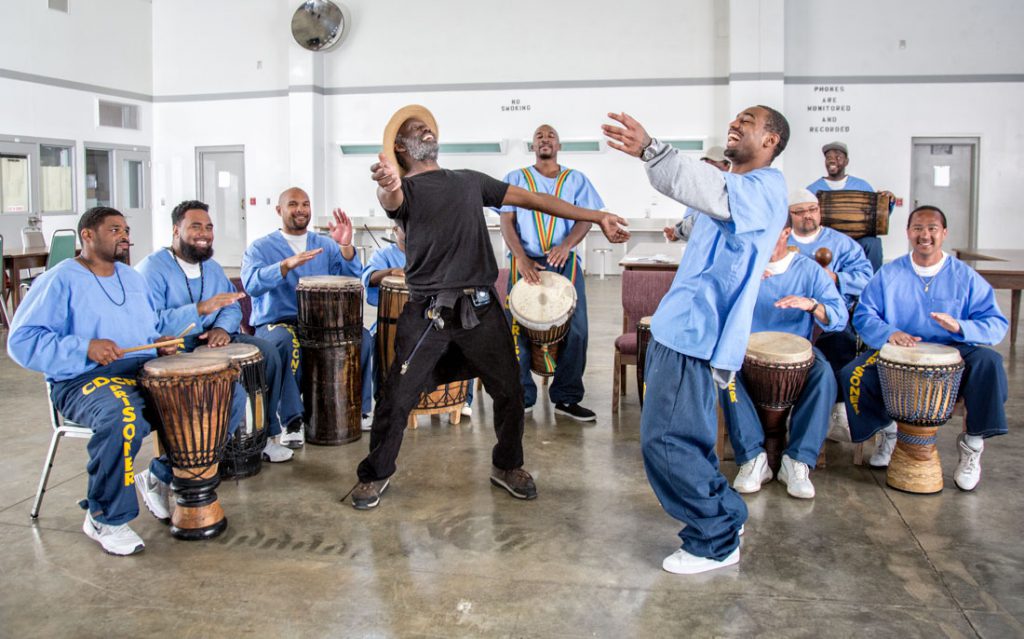
Peter Merts, Instructor Wilfred Mark of Dance Kaiso, in black, during drum and dance class at Salinas Valley State Prison, 2015, archival pigment print, 16 x 20 inches.
Disruption! Art and the Prison Industrial Complex
Curated by Annie Buckley
Artists: Karla Diaz, Stan Hunter, Peter Merts, Javier Quintero, Tony Ramirez, Paul Rucker, Gregory Sale, Noelle Swan, Robert Yovanov
September 14 – December 6, 2019
Opening Reception: September 14 from 2–4 p.m.
Performance: Karla Diaz at 2:30 p.m.
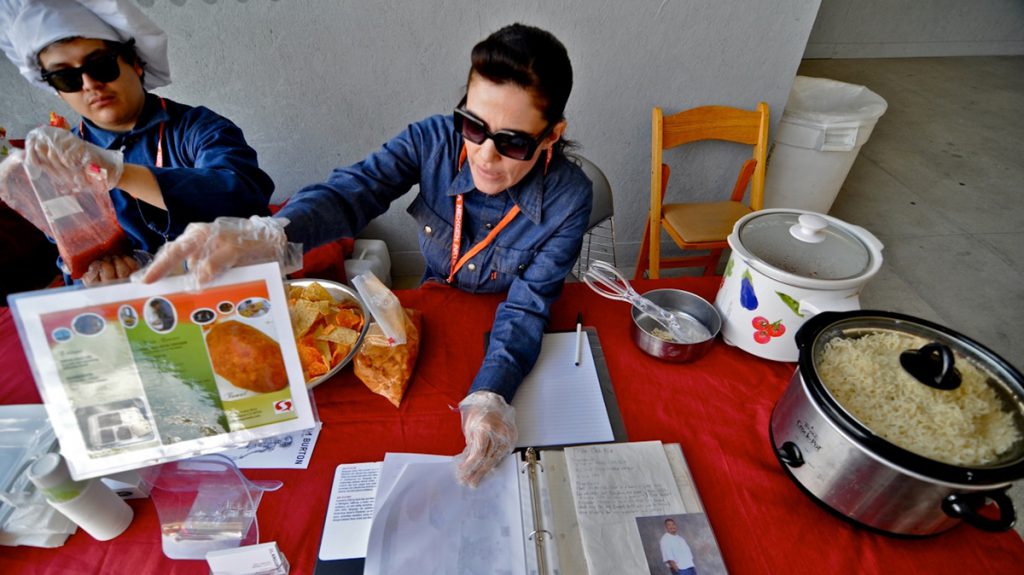 Karla Diaz’s performance reflects her ongoing interest in social justice and the politics of food and is part of Diaz’s multimedia “Prison Gourmet” project, which features recipes created by people incarcerated in California using items found in the commissary.
Karla Diaz’s performance reflects her ongoing interest in social justice and the politics of food and is part of Diaz’s multimedia “Prison Gourmet” project, which features recipes created by people incarcerated in California using items found in the commissary.
The tragic facts of the history of incarceration in America are now widely recognized. That we imprison more people than anywhere else on the planet, for longer sentences, and in harsh conditions, is seen as a pressing problem across political aisles. Yet the trenchant issues of racial and economic injustice continue to plague a swollen system that ensnares millions of Americans. While incarcerated individuals are the most directly impacted, tendrils stretch into families and communities disproportionately impacted by violence and the criminal justice system. But the complexity of the system and efforts at reform are dwarfed by the cycle of trauma that inscribes and abets it. In the movement for prison reform, the expression “hurt people hurt people” has become a kind of mantra for a reason. Crime and its impacts are not individual issues but communal and familial ones, with deep roots in slavery, inequity, and domestic violence.
Where does art fit into all of this? How can the arts disrupt cycles of trauma and promote healing and connection, inspire education and social change? Within the strict confines and jagged social structure of the American prison system, art plays a particularly poignant and pressing role. It is often the only outlet an individual stripped of rights has to give voice to thoughts and ideas, memories and dreams. For contemporary artists beyond the walls, art can be a means to critique, dialogue, and imagine solutions to the intractable problems of the prison industrial complex.
Disruption! brings together artists directly impacted by the system with artists that address it in their work. The multimedia artist Paul Rucker’s immersive installation, Proliferation, 2005, demonstrates the social, geographical, political, and emotional impact of the growth of prisons in the United States from 1778 to 2005, making space for pause and reflection, while Peter Merts’ moving photographs of Arts in Corrections give voice to those trapped in the system and embody the power of the arts to cultivate joy, imagination, and freedom in the most restrictive environments. In a solitary cell, with nothing but the blue uniform on his back, Tony Ramirez uses precious morning coffee and a handmade brush to paint a series of portraits of his hero, President Barack Obama; also behind bars, Javier Quintero, innovates a painstakingly detailed drawing style to create photorealistic portraits of himself with his wife to mail to her.
Artists Gregory Sale and Karla Diaz each collaborate with system-impacted individuals and communities to create participatory performances and social practice works, respectively, that offer meaningful opportunities for connection, dialogue, and common ground. Photographer Noelle Swan explores the complex emotional layers of the impact of murder on her family and finds an unlikely avenue for healing in the restorative justice movement, where the incarcerated individuals that she meets connect deeply to her family tragedy. Stan Hunter similarly locates healing through art. Hunter taught himself to paint while incarcerated for 30 years. Recognizing the powerful impact art had on his own growth, Hunter began to teach others inside to paint. Now released, he is a Lead Teaching Artist with the Prison Arts Collective, taking the journey full circle.
Artist Bios
Karla Diaz is an artist, writer, educator, and activist born in Los Angeles and raised in both Mexico and L.A. Her multidisciplinary work questions institutional power, investigates language, explores cultural relationships, and provokes dialogue. She received her MFA from CalArts in 2004 and has published and exhibited her work in local, national, and international venues including MOCA, LACMA, MD2011 Medellin Colombia, Museo Cervantez in Spain, the Whitney in New York, the ICA in Boston, and the Serpentine Gallery in London. She is co-director and founding member of Slanguage Studio, an artist community space/collective, and has received several awards, notably a city of Los Angeles Arts Recognition Award and an Art Matters award for her “Prison Gourmet” project. She teaches at Cal State University Long Beach.
Stan Hunter is a practicing artist who taught himself to paint while incarcerated for over thirty years. Finding deep healing through art, he dedicated himself to sharing it with others and has supported numerous peers to find joy and meaning through art. He finds purpose in sharing his skills and artistic techniques with those who may be struggling to find their own purpose. Hunter is a founding member and lead teaching artist with the Prison Arts Collective.
Peter Merts has been a photographer for 40 years, specializing in fine art, documentary, and portrait styles. He has published, exhibited, and lectured in the US and abroad. For the past 12 years, Peter has documented California’s Arts in Corrections program—first as a volunteer, then under contract with the California Arts Council. He has photographed in all of California’s 36 adult state prisons and serves on the advisory board of the Prison Arts Collective. Peter co-published, with Dr. Larry Brewster, the book Paths of Discovery: Art Practice and Its Impact in California Prisons (now in its 2nd edition).
Javier Quintero is an artist that is currently incarcerated and serving four life sentences for crimes that he committed at age 15. He was sent to a maximum security prison at 17 and began to draw as a way to deal with a violent environment. Quintero explains that drawing “kept me sane” and, after many years behind bars, keeps him motivated and allows for enjoyment. In 2018, Quintero completed the Prison Arts Collective Facilitator Training. He often sends artwork to his wife, advocate Xochitl Quintero, who was instrumental in loaning pieces for this exhibition.
Tony Ramirez is an artist that is currently incarcerated in Ironwood State Prison. Ramirez paints, draws, and has been teaching others to do the same ever since he learned. He is well respected among his peers for his mentorship and innovation, evidenced in this exhibition by portraits made in coffee. Currently struggling with losing his eyesight, Ramirez is learning to play the guitar. Ramirez has also been a Peer Facilitator in the Prison Arts Collective since 2017.
Paul Rucker is a composer, musician, and visual artist who combines media, often integrating live performance, sound, video, animation, original compositions, storytelling, and visual art. His work is the product of a rich interactive process, through which he investigates community impacts, human rights issues, historical research, and basic human emotions surrounding particular subject matter. Much of his current work focuses on dismantling inequity in order to create positive change. Rucker has received numerous grants, awards, and residencies for visual art and music. Among many notable achievements are an award for Visual Art from the Creative Capital Foundation, the John Simon Guggenheim Fellowship, the first artist-in-residence at the National Museum of African American Culture, a residency at the Joan Mitchell Center, and a TED Fellow.
Artist Gregory Sale brings together a multitude of individuals implicated in and working with the criminal justice system. His projects organize frameworks of engagement for individuals directly affected by the system, connecting them with communities and encouraging reciprocal dialogue and mutual learning. His projects include It’s not just black and white (2011) at ASU Art Museum, and Future IDs at Alcatraz (2018-19) for the iconic prison turned National Park in San Francisco Bay. His work has received support from the Kenneth Rainin Foundation, Creative Capital, A Blade of Grass, and Andy Warhol Foundation. He teaches at Arizona State University.
Noelle Swan is a documentary and editorial photographer that uses still and video images in visual storytelling. Her work has been published and exhibited internationally. In 2010, Noelle was a Critical Mass finalist for Life After Death, a body of work documenting the tragic effects of her sister’s murder, and in 2011, she was nominated for the Santa Fe Prize in Photography. Noelle is a founding member of SIX SHOOTERS, a group of six female photographers, and is currently focused on personal photographic projects, writing and restorative justice.
Robert Yovanov is an artist that is currently incarcerated at the California Institution for Men in Chino. He became involved in the Community-based Art program, now the Prison Arts Collective, in 2013 and has been an active peer leader in the program ever since. He is a cartoonist and is learning to paint. He also teaches a popular Foundations in Art class with the Prison Arts Collective and continues to support the growing arts community at the institution.
About the Curator
Annie Buckley is a multidisciplinary artist, writer, and curator with an emphasis on art and social justice and, since July 2019, the Director of the School of Art + Design at San Diego State University. She has written extensively about art for leading publications in the field including Artforum, Art in America, The Huffington Post, and KCET Artbound and is a contributing editor to the Los Angeles Review of Books for which she writes the series, “Art Inside” about facilitating art programs in prisons. Annie is the founder of the Prison Arts Collective, a statewide program dedicated to expanding access to the transformative power of the arts through collaboration and mutual learning. She has received numerous grants and contracts to support this work, including from Arts in Corrections, an initiative of the California Arts Council and the California Department of Corrections and Rehabilitation, CDCR Innovative Grants, and the National Endowment for the Arts.
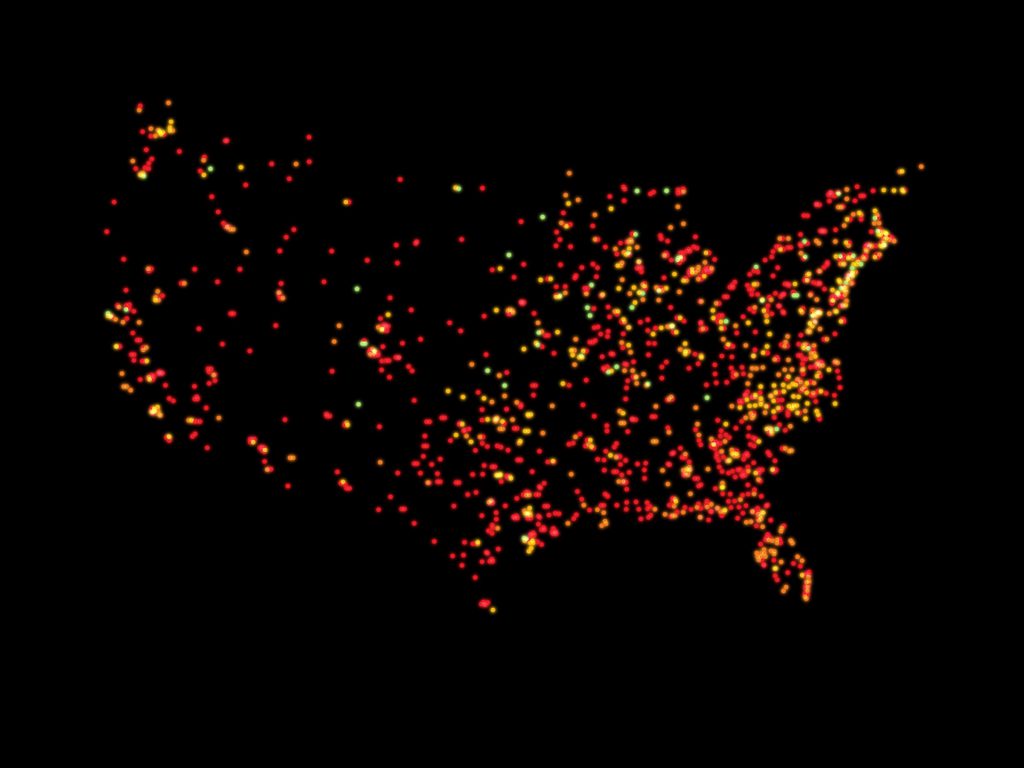
Special Event:
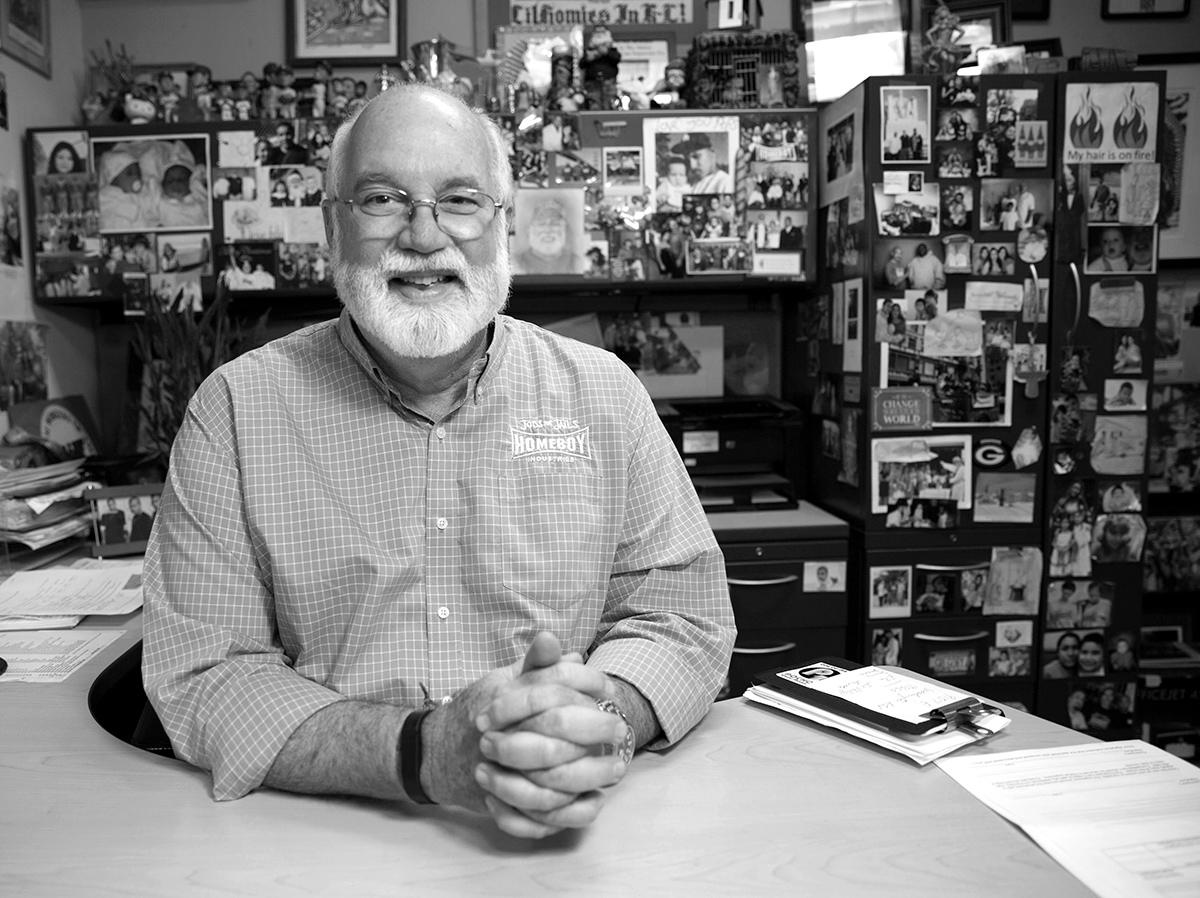
Murray Pepper and Vicki Reynolds Pepper Distinguished Visiting Artists & Scholars Lecture Series
Tuesday, December 3 at 4:15 p.m., Benson Auditorium, Pitzer College
Keynote Lecture by Father Gregory Boyle, SJ, founder of Homeboy Industries, the largest gang intervention, rehabilitation and re-entry program in the world.
Gregory Boyle is the founder of Homeboy Industries in Los Angeles, the largest gang intervention, rehabilitation and re-entry program in the world.
Related Events
* Please note: All exhibition events will take place on the Pitzer campus and in correctional institutions. Events on campus are open to the public. Events in corrections are by invitation.*
Thursday, September 26, 1:20 – 4 p.m., Pitzer College
The Actor’s Gang Reentry Project: Open Workshop/Performance of Commedia dell’Arte
The Actor’s Gang at the California Institution for Women, Sept 21 from 9 a.m. – 1 p.m.
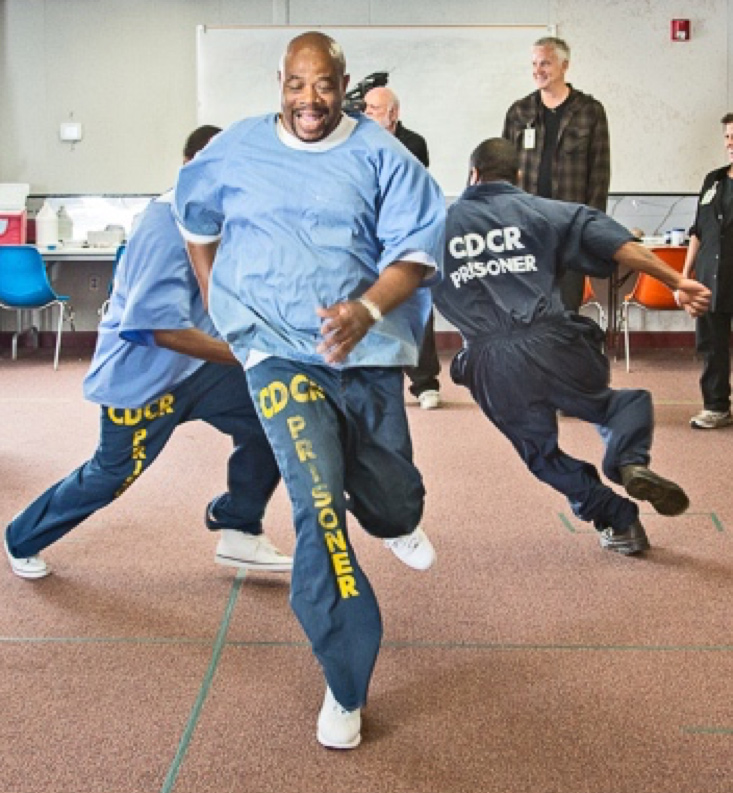
The Actors’ Gang Reentry Project will host an open workshop/performance of Commedia dell’Arte co-facilitated by formerly incarcerated alumni. Participants will experience the highly physical and emotional style of improvised theater taught by The Actors’ Gang Prison Project for the last thirteen years throughout California’s state prisons.
October 24, 1:20 – 4 p.m., Pitzer College
The Strindberg Laboratory and Kukunori co-lead a workshop together with over 50 organizations and individuals creating a world without labels and walls
Strindberg and Kukunori at the California Institution for Women, Oct. 24, 9:30 – 11:30 a.m.

The Strindberg Laboratory joins with the Finnish group Kukunori and the international coalition, No Labels, No Walls, to conduct a theater art workshop to create flags for a world without labels and walls. The flags will represent the participants’ views on what it means to be free from stigma and in a world where equality is a reality. Join the movement!
November 21, 1:20 – 4:00 p.m., Pitzer College
Prison Arts Collective: Exhibition Walkthrough and Responsive Art Workshop
Prison Arts Collective at California Institution for Men, Nov. 8, 9:30 – 11:30 a.m.

The Prison Arts Collective will present a guided exhibition tour and responsive art workshop. Participants will gain insight into the meaning and experience of art in prison, engage in dialogue about the impact of art in the restorative justice movement, and create art and writing projects to reflect on the issues, narratives, and emotional responses to the exhibition.
This exhibition and related events are generously supported by the Justice Education Initiative at the Claremont Colleges, funded by The Andrew W. Mellon Foundation; Murray Pepper and Vicki Reynolds Pepper Distinguished Visiting Artists and Scholars Endowed Fund; and Office of the Dean of Faculty at Pitzer College.
Links and Recommended Resources
Partners and Collaborators
Prison Arts Collective
Homeboy Industries
The Actors’ Gang Prison Project
Strindberg Laboratory: No Labels, No Walls
Criminal Justice in the United States
Fact Sheet, compiled by the NAACP
Criminal Justice Facts: The Sentencing Project
Criminal Justice Reform: Southern Poverty Law Center
 WORLD IS WATCHING – MANIFESTO
WORLD IS WATCHING – MANIFESTO